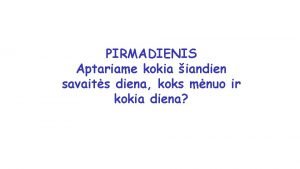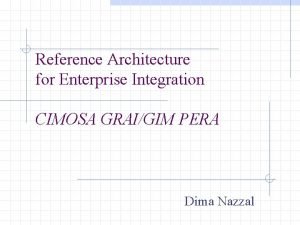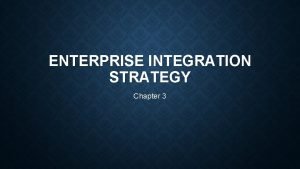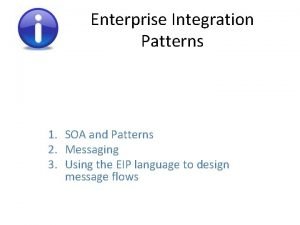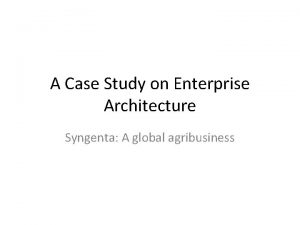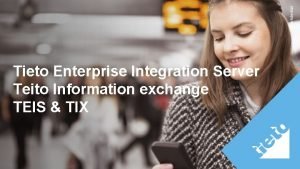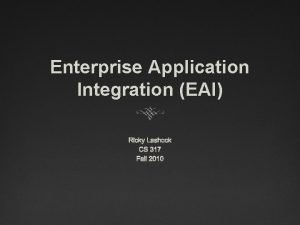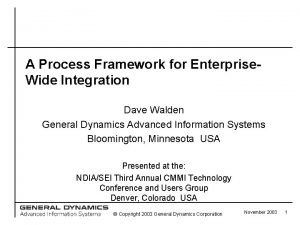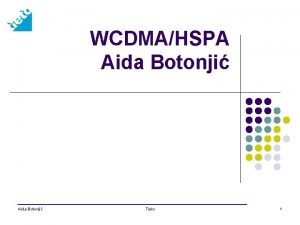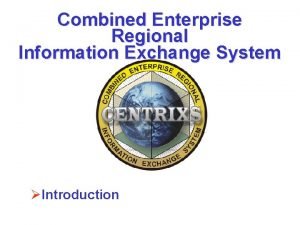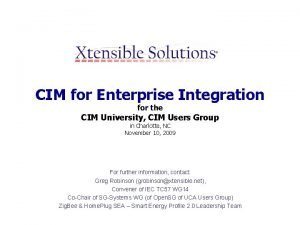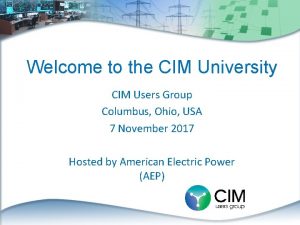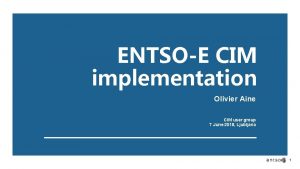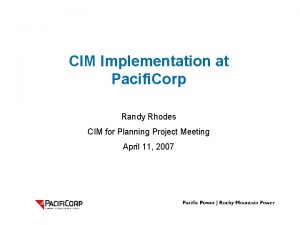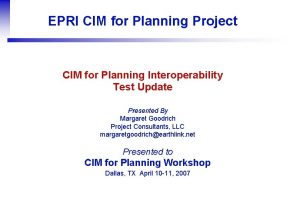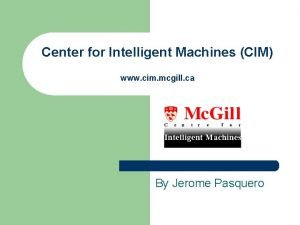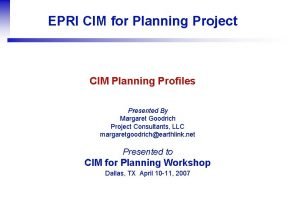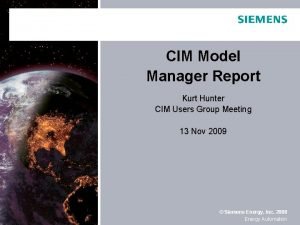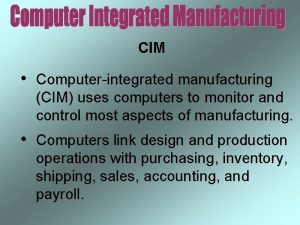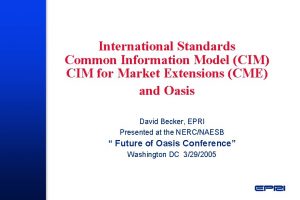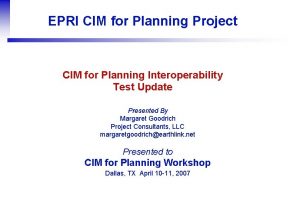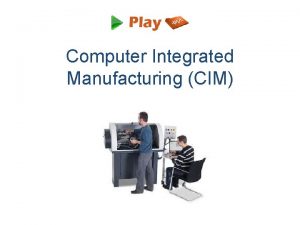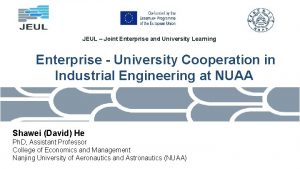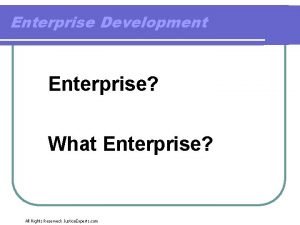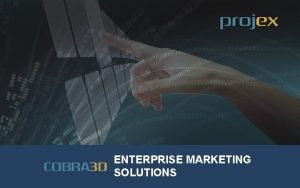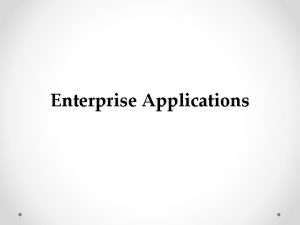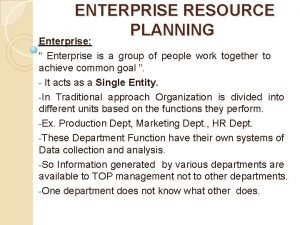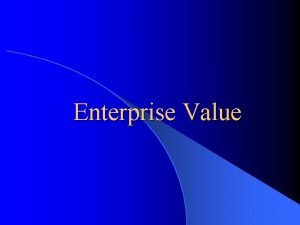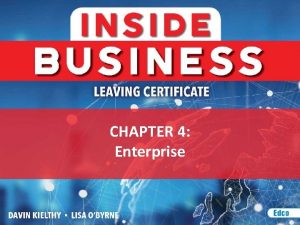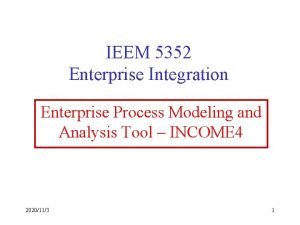CIM for Enterprise Integration for the CIM University











![(IEC 61968 Verbs - continued) [source: IEC 61968 -1] CIM Users Group: CIM for (IEC 61968 Verbs - continued) [source: IEC 61968 -1] CIM Users Group: CIM for](https://slidetodoc.com/presentation_image/303ef2203831733972e86777ac8efbf6/image-12.jpg)
![Example of a “message type” payload [source: IEC 61968 -1] CIM Users Group: CIM Example of a “message type” payload [source: IEC 61968 -1] CIM Users Group: CIM](https://slidetodoc.com/presentation_image/303ef2203831733972e86777ac8efbf6/image-13.jpg)
![Example of how message elements are derived from the CIM [source: IEC 61968 -1] Example of how message elements are derived from the CIM [source: IEC 61968 -1]](https://slidetodoc.com/presentation_image/303ef2203831733972e86777ac8efbf6/image-14.jpg)







































- Slides: 53

CIM for Enterprise Integration for the CIM University, CIM Users Group in San Francisco, CA October 11, 2010 For further information, contact: Greg Robinson (grobinson@xtensible. net), Convener of IEC TC 57 WG 14 Co-Chair of SG-Systems WG (of Open. SG of UCA Users Group) Zig. Bee & Home. Plug SEA – Smart Energy Profile 2. 0 Leadership Team NIST SGIP – Smart Grid Architecture Committee Member

Agenda • CIM for enterprise integration (IEC 61968) – Overall Scope, Approach – Messaging – Highlights for Using CIM • AMI, DMS, OMS, GIS, CIS • Asset management, work management – Supporting the smart grid CIM Users Group: CIM for Enterprise Integration Slide 2

This is Not a Good Practice For Wires Integration; It’s Not Good For Data Integration Either! Wires Integration Anarchy! CIM Users Group: CIM for Enterprise Integration Slide 3

Goal: Interface Standards Should Be Based on Common Semantics (e. g. , CIM) to Avoid Adding to ‘Integration Anarchy’ OMS GIS CIS Integration Infrastructure WMS DMS AMR Data Integration Anarchy! Integration anarchy is a chaos of: Without (1) duplicated logic, Common Semantics, Point (2) duplicated data, -to-Point (3) duplicated effort, Integration Will (4) newly acquired integration difficulties, Continue at the Data Level (5) lack of ability to easily create new application functionality from services, and (6) lack of ability to support business processes with applications Integration anarchy will result in higher costs and an inflexible, brittle Smart Grid Slide 4 System of Systems CIM Users Group: CIM for Enterprise Integration

The IEC 61968 -1 Interface Reference Model (IRM) Provides The Framework For Identifying Information Exchange Requirements Among Utility Business Functions Maintenance and Construction (MC) – IEC 61968 -6 IEC 61968 Sequence Diagrams are organized by the IRM Network Operations (NO) – IEC 61968 -3 Network Operations Monitoring (NMON) Network Control (CTL) Fault Management (FLT) Operation Statistics & Reporting (OST) Network Calculations - Real Time (CLC) Dispatcher Training (TRN) Operational Feedback Analysis (OFA) Records & Asset Management (AM) – IEC 61968 -4 & Substation Network Inventory (EINV) Geographical Inventory (GINV) Maintenance & Inspection (MAI) Operational Planning & Optimization (OP) – IEC 61968 Network 5 Operation Construction WMS (CON) Design & Estimate (DGN) Simulation (SIM) General inventory management (GIM) Asset Investment Planning (AIP) Scheduling & Dispatch (SCH) Switch Action Scheduling (SSC) Power Import Sched. & Optimization (IMP) Field Recording (FRD) Application Integration Infrastructure Network Extension Planning (NE) – IEC 61968 Network 7 Calculations (NCLC) Customer Support (CS) – IEC 619688 Customer Service (CSRV) Project Definition (PRJ) Trouble Call Management (TCM) Construction Supervision (CSP) Point Of Sale (POS) Compliance Management (CMPL) Meter Reading & Control (MR) – IEC 61968 -9 External to DMS (EXT) Meter Reading (RMR) Meter Data Management IMDM) Energy Trading (ET) Customer Account Management (ACT) Advanced Metering Infrastructure (AMI) Metering System (MS) Retail (RET) Financial (FIN) Demand Response (DR) Meter Maintenance (MM) Sales (SAL) Business Planning & Reporting (BPR) Load Control (LDC) Meter Data (MD) Stakeholder Planning & Management (SPM) Premises (PRM) Supply Chain & Logistics (SC) Human Resources (HR) Meter Operations (MOP) CIM Users Group: CIM for Enterprise Integration Slide 5

Key Concept: Incremental Integration - in Step With Business Needs OMS GIS CIS OR TT IEC 61968 IRM Interface Semantically Consistent ESB AMR WMS DMS Information Flow Design Trouble Ticket Outage Record CIM Users Group: CIM for Enterprise Integration DMS OMS CIS TT OR Slide 6

Key Concept: Replace Large Monolithic Applications ‘a Chunk at a Time’ Other Apps Field Recording Maintenance & Inspection Construction Work Scheduling Design CIM Message Types WMS CIM Users Group: CIM for Enterprise Integration Slide 7

Agenda • CIM for enterprise integration (IEC 61968) – Overall Scope, Approach – Messaging – Highlights for Using CIM • AMI, DMS, OMS, GIS, CIS • Asset management, work management – Supporting the smart grid CIM Users Group: CIM for Enterprise Integration Slide 8

IEC 61968 Basic Message Structure • A verb to identify the type of action being taken • A noun, to identify the type of the payload • The payload, which contains the data relevant to the information exchange as defined using a profile [source: IEC 61968 -1] CIM Users Group: CIM for Enterprise Integration Slide 9

Message Header Field Description Verb This enumerated list of verbs can be used to form message types in compliance with the IEC 61968 standard Noun The Noun identifies the main subject of the message type, typically a real world object defined as a profile using the CIM. Revision level of the message type. Context Intended context for information usage such as production, testing and etc. Timestamp Application level relevant time and date for when this instance of the message type was produced. This is not intended to be used by middleware for message management. Source person or system that publishes the message Async. Reply. Flag Indicates whether or not reply should be asynchronous Reply. Address to be used for asynchronous replies Ack. Required Indicates whether or not an acknowledgement is required User information of the sender Message. ID Unique message ID to be used for tracking messages Correlation. ID ID to be used by applications for correlating replies Comment Optional comment Property Message properties can be used to identify information needed for extended routing and filtering capabilities. [source: IEC 61968 -1] CIM Users Group: CIM for Enterprise Integration Slide 10

Message Types Are Created By Combining IEC 61968 Verbs With Information Exchange Topics, Referred To As Nouns [source: IEC 61968 -1] CIM Users Group: CIM for Enterprise Integration Slide 11
![IEC 61968 Verbs continued source IEC 61968 1 CIM Users Group CIM for (IEC 61968 Verbs - continued) [source: IEC 61968 -1] CIM Users Group: CIM for](https://slidetodoc.com/presentation_image/303ef2203831733972e86777ac8efbf6/image-12.jpg)
(IEC 61968 Verbs - continued) [source: IEC 61968 -1] CIM Users Group: CIM for Enterprise Integration Slide 12
![Example of a message type payload source IEC 61968 1 CIM Users Group CIM Example of a “message type” payload [source: IEC 61968 -1] CIM Users Group: CIM](https://slidetodoc.com/presentation_image/303ef2203831733972e86777ac8efbf6/image-13.jpg)
Example of a “message type” payload [source: IEC 61968 -1] CIM Users Group: CIM for Enterprise Integration Slide 13
![Example of how message elements are derived from the CIM source IEC 61968 1 Example of how message elements are derived from the CIM [source: IEC 61968 -1]](https://slidetodoc.com/presentation_image/303ef2203831733972e86777ac8efbf6/image-14.jpg)
Example of how message elements are derived from the CIM [source: IEC 61968 -1] CIM Users Group: CIM for Enterprise Integration Slide 14

Navigating associations in CIM (UML notation) CIM Users Group: CIM for Enterprise Integration Slide 15

Navigating associations in message type schemas CIM Users Group: CIM for Enterprise Integration Slide 16

Agenda • CIM for enterprise integration (IEC 61968) – Overall Scope, Approach – Messaging – Highlights for Using CIM • AMI, DMS, OMS, GIS, CIS • Asset management, work management – Supporting the smart grid CIM Users Group: CIM for Enterprise Integration Slide 17

Case Study: LIPA Asset Management and Organization Asset Owner Responsibilities: (source: IEEE 2009) Asset Manager • Asset Optimization • Asset yield contribution understanding • Financial structuring • Business development • Asset specifications & standards • Full lifecycle asset management • Asset data management • Workload management • Asset financial and operating performance analysis • Asset strategy & plan development • Asset full lifecycle financial & operational data analysis • Regulatory strategy & negotiation • Contract management • Risk management • Asset data requirements definition • Asset opportunity development & analysis • Industry Best Practices • • Asset valuation Investment analysis & strategy Contract negotiation/structuring Regulatory oversight Market & economic analysis Portfolio management Capital allocation Asset financial & operating performance analysis • Asset planning • Asset acquisition & monetization Service Provider Responsibilities: • Construction & maintenance project management • Materials sourcing & inventory management • System engineering & design • Bargaining unit negotiations • Workforce scheduling & deployment • Work practice design & development • Asset data input and collection • Workforce training • Marketing & sales of services • Competitor analysis CIM Users Group: CIM for Enterprise Integration Slide 18

Case Study: LIPA Asset Management Concept CIM Users Group: CIM for Enterprise Integration (source: IEEE 2009) Slide 19

Some Foundational Relationships of the IEC CIM for Asset Management Document Organisation Information Containers Such As Asset Catalogues, Trouble Tickets, Work Orders, etc. Entities Performing One or More Roles Such As Customer, Supplier, Manufacturer, Service Provider, etc. Location Erp Person A Street Address, Coordinates For a Geographic or Schematic reference system, etc. A Person Performing Roles Such Dispatcher, Field Operator, etc. Power System Resource Activity Record Electrical Network Role Used For Planning, Operations, etc. Used to Record Each State change of CIM objects Type Asset Model Compatible Unit For Design & Procurement Particular Model and Version of a Vendor's Product Asset Physical Plant Filling A Role Such As A Transformer, Pole, etc. CIM Users Group: CIM for Enterprise Integration Slide 20

IEC 61968 -4: Records and Asset Management (Note: Maintenance Update in Process) • Network Data Set – Contains data for any part of a distribution network: • • • Typically selected for operational or extension planning studies Used in numerous implementations for GIS to DMS integration Can be part of a feeder, a single feeder or more than one feeder Can be either the ‘As built’ network or a proposed network selected for analysis It is a superset of IEC 61968 -13 CDPSM (i. e. , Distribution’s CPSM) – Contains references to other static data such as: • • • Elements of a Type. Asset. Catalogue Elements of a Asset. Catalogue Assets performing the roles of the associated types of Power. System. Resources Other “leaf node” elements such as Organisations, Locations, and Measurements Change Set – Contains updates required in a transaction for an existing Network. Data. Set – Each step in the Change. Set is described through a separate Change. Item. • A change item identifies the change type (add, delete, modify) • Sequence number for a particular change within a set of changes of a Change. Set. – Only the identifiers of the relevant Network. Data. Set messages are to be included in a Chage. Set message. • The actual contents are provided in accompanying Network. Data. Sets messages. CIM Users Group: CIM for Enterprise Integration Slide 21

From the logical view to the physical asset view of the same object. CIM Users Group: CIM for Enterprise Integration Slide 22

IEC 61968 -4: Records and Asset Management (Note: Maintenance Update in Process) • Presentation: – Can contain location information for most any element represented in the CIM, particularly elements of the distribution network. – Provides location information of individual assets or power system resources – Provides a set of location information as a companion to the Network. Data. Set. • Asset List: – Can contain various amounts of data for any set of utility assets – Contains references to static reference data such as: • Elements of an Asset. Catalogue • Elements of a Type. Asset. Catlogue • Power. System. Resources that specify the role in which the Asset is being used – If it has been installed rather than sitting in inventory • Other “leaf node” elements such as Organisations, Locations, and Measurements CIM Users Group: CIM for Enterprise Integration Slide 23

Case Study: Asset Management System Used to Initialize System Control Center System (source: Distribu. TECH 2002) Asset Management Asset data sent in XML Adapter Transformation into CIM Objects Publish AMS data in CIM format Integration Bus Adapter Subscribe to Asset data System Control Center [presented at Distribu. TECH 2001] CIM Users Group: CIM for Enterprise Integration Slide 24

Case Study: Operations Model Capabilities (source: Distribu. TECH 2002) AMS DMS CIM Users Group: CIM for Enterprise Integration Slide 25

CIM Users Group: CIM for Enterprise Integration Slide 26

IEC 61968 -4: Records and Asset Management (Note: Maintenance Update in Process) • Asset Catalogue: – A collection of information regarding available types of products and materials that are used to build or install an Asset(s), to maintain an Asset(s) or to operate an Asset(s). – Each catagoue item is for a specific product available from a specific supplier. – Contains references to static reference data such as: • Elements of a Type. Asset. Catalogue • Specifications • Other “leaf node” elements such as Organisations • Type Asset Catalogue – Contains data for a set of utility asset types – It is a collection of information regarding generic types of assets that may be used for design purposes, analysis, and so on – A Type. Asset is not associated with a particular manufacturer – Contains references to other Documents containing static reference data such as: • Elements of an Asset. Catalogue • Other “leaf node” elements such as Organisation CIM Users Group: CIM for Enterprise Integration Slide 27

IEC 61968 -6: Maintenance & Construction (Note: CD in development – paper being presented at Grid Inter. Op) Maintenance and Construction (MC) – IEC 61968 -6 Maintenance & Inspection (MAI) Construction WMS (CON) Design & Estimate (DGN) Business Functions Performed • • Maintain and Plan PM Programs Manage Inspection and Maintenance “Triggers” Link Inspection orders to follow-up repair orders Gather “failure” data • • Initiate and Plan work orders Manage material, equipment, and permit requests Manage and Track Work (Workflow) Close Work and Support Performance Analysis • Work Design and Cost Estimation • Compatible Unit based Graphical design • Generate Bill of Materials Scheduling & Dispatch (SCH) • Assign crew based on work type and skills • Determine Schedule Date • Perform constraint-based “auto-scheduling” Field Recording (FRD) • Gather actual costs and support cost reconciliation • Monitor work progress • support financial closing with accounting systems CIM Users Group: CIM for Enterprise Integration Slide 28

IEC 61968 -6: Maintenance & Construction • Work is created any time a person is required to perform an activity related to company assets. Examples of work include – Construction work (e. g. service installations, line extensions, and system betterment projects) – Service work (e. g meter replacements, Turn-on, Turnoff, etc. ) – Maintenance work (e. g. routine oil changes, painting, etc. ) – Inspection work (e. g. pole inspections, vault inspections, Substation inspections) – Trouble work (e. g. Power outage, voltage quality problem, etc. ) CIM Users Group: CIM for Enterprise Integration Slide 29

IEC 61968 -6: Construction & Maintenance • Current Message Types: – – – – Compatible Units Construction Work Crew Design Inspect & Test Labor One Call Request Procedure Service Work Trouble Work Cost Detail Work Scheduling Work Status Work Task CIM Users Group: CIM for Enterprise Integration Slide 30

Generic “Type. Assets” are used for Design CIM Users Group: CIM for Enterprise Integration Slide 31

IEC 61968 -3: Network Operations (Note: Maintenance Update in Process) • Current Message Types: – Measurement list; – Operational restrictions; – Outage records; – Safety documents; – Switching schedules. • Regarding “Note”, currently being updated through a use case-driven and incremental maintenance cycle, with first iteration being in support of outage management. CIM Users Group: CIM for Enterprise Integration Slide 32

An Example: Safety Document Classes CIM Users Group: CIM for Enterprise Integration Slide 33

Safety Document Message Type CIM Users Group: CIM for Enterprise Integration Slide 34

IEC 61968 -8: Customer Support (Note: Update to second CD in Process) • Current Message Types: – – – Trouble Ticket Failure Event Planned Outage Notification Call Back Compliance Event Outage History Service Extension Request Service. Request Customer. Service. Agreement Customer Billing Construction Billing CIM Users Group: CIM for Enterprise Integration Slide 35

Aspects of Customer Accounts CIM Users Group: CIM for Enterprise Integration Slide 36

A Customer Account Message Type for AMI CIM Users Group: CIM for Enterprise Integration (IEC 61968 -9) Slide 37

IEC 61968 -9 Reference Model Refer to Margaret’s presentation CIM Users Group: CIM for Enterprise Integration

Agenda • CIM for enterprise integration (IEC 61968) – Overall Scope, Approach – Messaging – Highlights for Using CIM • AMI, DMS, OMS, GIS, CIS • Asset management, work management – Supporting the smart grid CIM Users Group: CIM for Enterprise Integration Slide 39

NIST Conceptual Model CIM Users Group: CIM for Enterprise Integration Slide 40 [Source: NIST Interim Roadmap]

User groups are a good source of help http: //www. ucaiug. org/ CIM Users Group: CIM for Enterprise Integration Slide 42

CIM Users Group: CIM for Enterprise Integration Slide 43

Key Collaboration Concept for the SG-Systems Working Group • Standard building blocks are defined by standards development organizations (SDOs) • Requirements (use cases) are gathered from helpful sources – Utilities – Industry initiatives • The SG-Systems WG articulates Industry Best Practices (see next slide) that satisfy requirements through the use of standard building blocks. – Recommended extensions and changes to standard building blocks are provided back to appropriate standards bodies. CIM Users Group: CIM for Enterprise Integration Slide 44

Open. SG Focus: Finding/Developing Best Practices & Making Them into Vetted “Industry Best Practices” Utility’s Projects - Design & Implementations ------- Utility’s Architecture -----------Industry Best Practices Interoperability Testing ----------------- Industry Best Practices • Local Utility Projects • Consortiums & User Groups like Open. SG (business requirements) & CIMug (optimization & implementation support) • Standards Development Organizations (SDOs) like IEC TC 57 Working Group 14 for the IEC 61968 series of standards, NAESB, IEEE, et al. ---------------------Standards Conformance & Interoperability Testing CIM Users Group: CIM for Enterprise Integration

(of UCAIug/Open. SG/SG-Systems WG) • The scope of AMI-ENT is the systems and/or applications within and around the utility enterprise and the inter-systems related business functions and stops at the boundaries of applications and the edge of utility enterprise. • The focus is on how these systems are to be integrated and composed to support AMI related business processes and functions. • Edge applications are those applications that communicate with networks and devices in the field, as well as those that Slide 46 CIM Users Group: CIM for Enterprise Integration communicate with other businesses or enterprises (generally defined as third parties).

Case Study: Consumers Energy and AMI-Ent TF CIM Users Group: CIM for Enterprise Integration Slide 47

Case Study: AMI-Ent Service Identification CIM Users Group: CIM for Enterprise Integration Slide 48

Case Study: AMI-Ent Inventory of CIM-Based Services Supporting Use Cases for AMI-Enterprise CIM Users Group: CIM for Enterprise Integration Slide 49

Application View CIM Users Group: CIM for Enterprise Integration Slide 50

Technical View (Patterns) CIM Users Group: CIM for Enterprise Integration Slide 51

Common Concerns About The CIM for Integration – Concern 1: the CIM is too large • For the common systems language, the CIM can be thought of as the unabridged dictionary. It is important to note that projects only use the portion of the dictionary relevant to their implementation • But as the dictionary is is much richer, there will be consistency and congruity for other areas that the implementation must interface with. – Concern 2: the CIM inhibits innovation • Because people don’t have to waste time re-inventing things that have been well vetted in the community, they can leverage the existing dictionary while focusing more energy on their innovative concept. • Not only is this more efficient for the innovator, but it is also much more efficient for the people the innovators wants to share his ideas with. The community is already educated on how to use the well vetted language. – Concern 3: the CIM is too slow • This is like saying the English language is slow; it is based on the speakers command of the language and the choice of media used. • When a person communicates with someone, they must: 1. Articulate the information for the receiver to comprehend it 2. As a person may then provide this information through the US Postal Service, through email, through phone calls, etc. , the system may provide this information over many types of middleware (messaging, file transfers, data base, etc. ) [source: IEEE T&D Optimization Panel 2010] CIM Users Group: CIM for Enterprise Integration Slide 52

Common Concerns About The CIM for Integration (continued) – Concern 4: The CIM is too abstract • This quality enables the CIM to continue to be relevant and valid even as technology continuously changes. The ability to properly convey unambiguous information primarily boils down to one’s skills in applying the common systems language. – Concern 5: The CIM is not a best practice data model • For any individual purpose, one can always invent a model that is superior to any other existing model. • The CIM has not been developed for only one functional area, but rather by a wide range of domain experts for integrating disparate applications. So for inter-application integration purposes, a superior model does not exist and would be difficult to achieve. – Concern 6: The CIM is too hard to implement • Specialized models are often biased for a particular implementation and used with the a specific implementation technology. If the implementation never had to interface with other systems, this would be easier. • As the CIM is an information model that is technology neutral, using the CIM does require following a process that restricts the general information model for particular contexts and then generates the appropriate design artifacts. The CIM Community has been doing this for some time and many tools are available for automating the process. [source: IEEE T&D Optimization Panel 2010] CIM Users Group: CIM for Enterprise Integration Slide 53

Thank you for your time! • Good news: The CIM is being used extensively – so learning about it is time well spent. • Bad news: The CIM continues to need a lot of work and therefore users must be prepared for revision management • Fun news: The CIM is a key NIST standard – so we have many exciting adventures (HAN, DER, PEV, ADE, DR, etc. ) to look forward too! CIM Users Group: CIM for Enterprise Integration Slide 54
 Mnuo
Mnuo Three dimensions of corporate strategy
Three dimensions of corporate strategy Forward integration and backward integration
Forward integration and backward integration Simultaneous integration meaning
Simultaneous integration meaning Enterprise integration reference architecture
Enterprise integration reference architecture Presentation integration model example
Presentation integration model example Enterprise integration strategy
Enterprise integration strategy Enterprise application integration patterns
Enterprise application integration patterns Enterprise architecture case study
Enterprise architecture case study Teis tieto
Teis tieto Disadvantages of enterprise application integration
Disadvantages of enterprise application integration Gdais
Gdais Tieto enterprise integration server
Tieto enterprise integration server Centrixs
Centrixs Putting the enterprise into the enterprise system
Putting the enterprise into the enterprise system Putting the enterprise into the enterprise system
Putting the enterprise into the enterprise system Hát kết hợp bộ gõ cơ thể
Hát kết hợp bộ gõ cơ thể Lp html
Lp html Bổ thể
Bổ thể Tỉ lệ cơ thể trẻ em
Tỉ lệ cơ thể trẻ em Gấu đi như thế nào
Gấu đi như thế nào Glasgow thang điểm
Glasgow thang điểm Chúa yêu trần thế
Chúa yêu trần thế Các môn thể thao bắt đầu bằng tiếng bóng
Các môn thể thao bắt đầu bằng tiếng bóng Thế nào là hệ số cao nhất
Thế nào là hệ số cao nhất Các châu lục và đại dương trên thế giới
Các châu lục và đại dương trên thế giới Công của trọng lực
Công của trọng lực Trời xanh đây là của chúng ta thể thơ
Trời xanh đây là của chúng ta thể thơ Mật thư tọa độ 5x5
Mật thư tọa độ 5x5 101012 bằng
101012 bằng Phản ứng thế ankan
Phản ứng thế ankan Các châu lục và đại dương trên thế giới
Các châu lục và đại dương trên thế giới Thơ thất ngôn tứ tuyệt đường luật
Thơ thất ngôn tứ tuyệt đường luật Quá trình desamine hóa có thể tạo ra
Quá trình desamine hóa có thể tạo ra Một số thể thơ truyền thống
Một số thể thơ truyền thống Cái miệng nó xinh thế
Cái miệng nó xinh thế Vẽ hình chiếu vuông góc của vật thể sau
Vẽ hình chiếu vuông góc của vật thể sau Nguyên nhân của sự mỏi cơ sinh 8
Nguyên nhân của sự mỏi cơ sinh 8 đặc điểm cơ thể của người tối cổ
đặc điểm cơ thể của người tối cổ V cc cc
V cc cc Vẽ hình chiếu đứng bằng cạnh của vật thể
Vẽ hình chiếu đứng bằng cạnh của vật thể Tia chieu sa te
Tia chieu sa te Thẻ vin
Thẻ vin đại từ thay thế
đại từ thay thế điện thế nghỉ
điện thế nghỉ Tư thế ngồi viết
Tư thế ngồi viết Diễn thế sinh thái là
Diễn thế sinh thái là Dạng đột biến một nhiễm là
Dạng đột biến một nhiễm là Số nguyên tố là số gì
Số nguyên tố là số gì Tư thế ngồi viết
Tư thế ngồi viết Lời thề hippocrates
Lời thề hippocrates Thiếu nhi thế giới liên hoan
Thiếu nhi thế giới liên hoan ưu thế lai là gì
ưu thế lai là gì Khi nào hổ con có thể sống độc lập
Khi nào hổ con có thể sống độc lập
